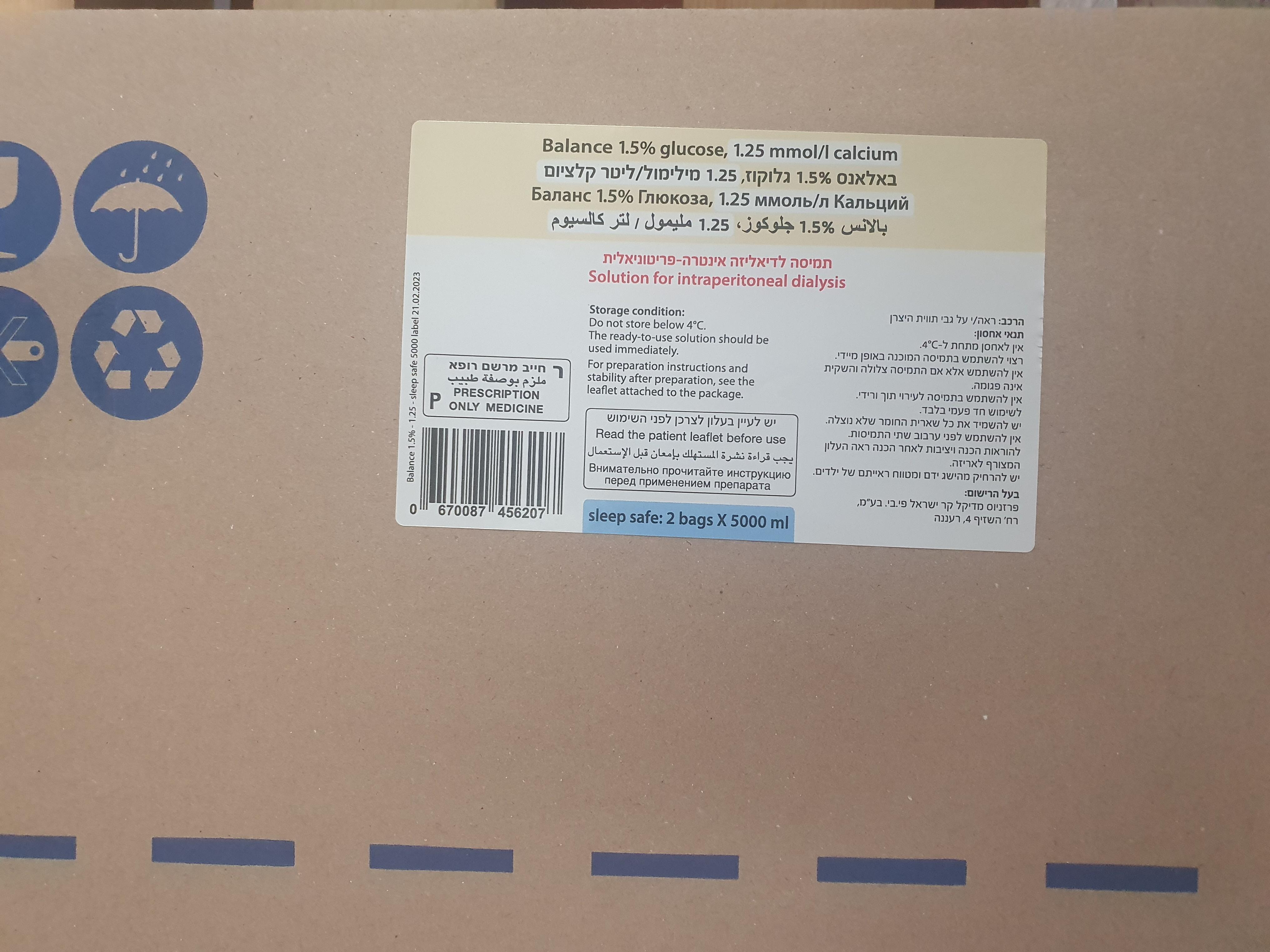Quest for the right Drug

באלאנס 1.5% גלוקוז, 1.25 מילימול/ליטר קלציום BALANCE 1.5 % GLUCOSE , 1.25 MMOL/L CALCIUM (CALCIUM CHLORIDE DIHYDRATE, GLUCOSE MONOHYDRATE, MAGNESIUM CHLORIDE HEXAHYDRATE, SODIUM (S) - LACTATE, SODIUM - (S) - LACTATE, SODIUM CHLORIDE)
תרופה במרשם
תרופה בסל
נרקוטיקה
ציטוטוקסיקה
צורת מתן:
לחלל הבטן : INTRAPERITONEAL
צורת מינון:
תמיסה לדיאליזה פריטוניאלית : SOLUTION FOR PERITONEAL DIALYSIS
עלון לרופא
מינוניםPosology התוויות
Indications תופעות לוואי
Adverse reactions התוויות נגד
Contraindications אינטראקציות
Interactions מינון יתר
Overdose הריון/הנקה
Pregnancy & Lactation אוכלוסיות מיוחדות
Special populations תכונות פרמקולוגיות
Pharmacological properties מידע רוקחי
Pharmaceutical particulars אזהרת שימוש
Special Warning עלון לרופא
Physicians Leaflet
Special Warning : אזהרת שימוש
4.4 Special warnings and precautions for use 3. PHARMACEUTICAL FORM The solution for peritoneal dialysis must not be used for intravenous infusion. Solution for peritoneal dialysis This solution may only be administered after careful benefit-risk assessment in: Double chamber bag containing clear and colourless aqueous solutions balance 1.5%/2.3%/4.25% glucose, 1.25 mmol/l calcium For the ready-to-use solution: • patients with hyperparathyroidism: Therapy should include the administration of calcium-containing phosphate binders and/or vitamin D to ensure adequate enteral balance balance balance balance balance balance calcium supply. 1.5% 2.3% 4.25% 1.5% 2.3% 4.25% • hypocalcaemia: It may be necessary to use a peritoneal dialysis solution with a higher glucose, glucose, glucose, glucose, glucose, glucose, calcium concentration either temporarily or permanently, in case an adequate enteral 1.25 1.25 1.25 1.75 1.75 1.75 supply of calcium, by calcium-containing phosphate binders and/or vitamin D, is not mmol/l mmol/l mmol/l mmol/l mmol/l mmol/l possible. calcium calcium calcium calcium calcium calcium balance 1.5%/2.3%/4.25% glucose, 1.75 mmol/l calcium Theoretical 356 399 509 358 401 511 osmolarity mOsm/l mOsm/l mOsm/l mOsm/l mOsm/l mOsm/l • hypercalcaemia, e.g. due to the administration of calcium-containing phosphate binders and/or vitamin D (a temporary or permanent change to a peritoneal dialysis pH ≈ 7.0 7.0 7.0 7.0 7.0 7.0 solution with a lower calcium concentration should be considered). 4. CLINICAL PARTICULARS balance 1.5%/2.3%/4.25% glucose, 1.25/1.75 mmol/l calcium • loss of electrolytes due to vomiting and/or diarrhoea (a temporary change to a 4.1 Therapeutic indications peritoneal dialysis solution containing potassium might then become necessary). End-stage (decompensated) chronic renal failure of any origin which can be treated with • patients receiving digitalis therapy: Regular monitoring of the serum potassium level peritoneal dialysis. is mandatory (see section 4.5). Severe hypokalaemia may necessitate the use of a 4.2 Posology and method of administration potassium-containing dialysis solution together with dietary counselling. • patients with large polycystic kidneys. Posology A loss of proteins, amino acids, and water-soluble vitamins occurs during peritoneal This solution is indicated exclusively for intraperitoneal use. dialysis. To avoid deficiencies an adequate diet or supplementation should be ensured. The mode of therapy, frequency of administration, and dwell time required will be The transport characteristics of the peritoneal membrane may change during long- specified by the attending physician. term peritoneal dialysis primarily indicated by a loss of ultrafiltration. In severe cases Continuous ambulatory peritoneal dialysis (CAPD) peritoneal dialysis must be stopped and haemodialysis commenced. Adults: Regular monitoring of the following parameters is recommended: Unless otherwise prescribed, patients will receive an infusion of 2000 ml solution per - body weight for the early recognition of over- and dehydration, exchange four times a day. After a dwell time between 2 and 10 hours the solution will - serum sodium, potassium, calcium, magnesium, phosphate, acid base status, blood be drained. gases and blood proteins, Adjustment of dosage, volume and number of exchanges will be necessary for - serum creatinine and urea, individual patients. - parathormone and other indicators of bone metabolism, If dilation pain occurs at the commencement of peritoneal dialysis, the solution volume - blood sugar, per exchange should be temporarily reduced to 500-1500 ml. - residual renal function in order to adapt the peritoneal dialysis. In large patients, and if residual renal function is lost, an increased volume of dialysis The effluent should be checked for clarity and volume. Turbidity and/or abdominal pain solution will be necessary. In these patients, or patients who tolerate larger volumes, a are indicators of peritonitis. volume of 2500-3000 ml solution per exchange may be given. Encapsulating peritoneal sclerosis is considered to be a known, rare complication of Paediatric population: peritoneal dialysis therapy which can infrequently lead to fatal outcome. In children the solution volume per exchange should be prescribed according to age Elderly and body surface area (BSA). The increased incidence of hernia should be considered in the elderly prior to the start For initial prescription, the volume per exchange should be 600-800 ml/m2 BSA with 4 of peritoneal dialysis. (sometimes 3 or 5) exchanges per day. It can be increased up to 1000-1200 ml/m2 BSA
Effects on Driving

שימוש לפי פנקס קופ''ח כללית 1994
לא צוין
תאריך הכללה מקורי בסל
לא צוין
הגבלות
לא צוין
מידע נוסף
עלון מידע לרופא
11.05.23 - עלון לרופאלתרופה במאגר משרד הבריאות
באלאנס 1.5% גלוקוז, 1.25 מילימול/ליטר קלציום